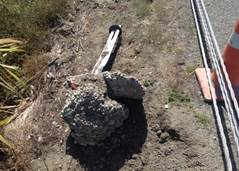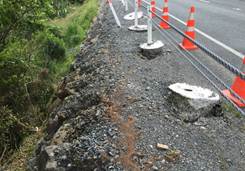Published: 24 February 2016 | Category: Technical advice note | Audiences: Road controlling authorities, Road traffic engineers & consultants, Roading contractors
Over recent months, the NZ Transport Agency has been made aware of a number of issues associated with the failure under impact of wire rope safety barrier (WRSB) post footings. The issues are generic in nature and not specific to any system.
To whom it may concern
Dear Sir/Madam
Wire Rope Safety Barrier systems – post footing issues
Over recent months, the NZ Transport Agency has been made aware of a number of issues associated with the failure under impact of wire rope safety barrier (WRSB) post footings (see photos below). The issues are generic in nature and not specific to any system.
Our concern is that the WRSB footing dimensions at installation locations are inappropriate for the soil conditions. This may result from a combination of inadequate site investigation during design, poor soil compaction during earthworks operations and/or poor installation practices. Additionally, limited in situ testing of WRSB installations may have masked any installation issues.
If a WRSB system has inadequate foundation support, this is likely to result in poor system performance when impacted. This increases the risk of serious injury to vehicle occupants, and increased maintenance costs for foundation repairs.


The following text details the Transport Agency’s expectations of the supply chain for the design and installation of WRSB systems.
It is wholly consistent with the Transport Agency M23 Specification for Road Safety Barrier Systems, AS/NZS 3845 Road Safety Barrier Systems and Devices, and the Transport Agency’s procurement and quality procedures:
The design of all permanent (or temporary) road safety hardware system installations shall be compliant with the crash tested design or the road safety hardware system configuration granted acceptance by the Transport Agency, as listed on the Transport Agency M23 webpage (www.nzta.govt.nz/resources/road-safety-barrier-systems).
The standard foundation for all WRSB systems is considered to be that used for the NCHRP 350 Test Level 4 crash tests; this being the minimum performance level for all 4 cable WRSB systems accepted for installation on the state highway network. Where applicable, MASH testing results may also be used.
It is strongly recommended that the Installation Designer and Peer Reviewer have attended and passed the Transport Agency Road Safety Barrier Design Course within the last five years. This course is held annually with the course details and dates are available on the Transport Agency website (https://www.nzta.govt.nz/resources/road-safety-barrier-systems/#training).
The design of all permanent road safety hardware system installations must take account of the ground conditions at the proposed installation site and should be within System Supplier acceptance. All NCHRP350 and MASH crash testing of accepted systems has been undertaken using standardised soil (to AASHTO M147 Grading A or B) for repeatability and consistency across test facilities.
The Installation Designer must confirm the ground conditions at the installation site as part of the design process. Results of this site investigation must be documented.
Where the ground conditions vary from the standardised soil, as detailed above, the Installation Designer must either amend the foundation design in accordance with the design/installation guidance provided by the System Supplier, or consider an alternative protection system.
The System Supplier must have available the design horizontal force(s) and/or bending moment(s) at a nominated height and at an angle of 90° to the barrier as measured from data recorded during crash testing of the WRSB system.
Where the ground conditions are outside those accepted by the System Supplier but the use of a WRSB system is considered the most appropriate barrier solution, the Installation Designer must apply to the Transport Agency’s National Traffic & Safety Manager for a departure acceptance.
The foundation design, together with all site investigation results, shall be retained as formal project records in accordance with the Transport Agency’s project documentation requirements.
The System Supplier shall have a static pull test procedure available for testing the WRSB foundations to ensure the system will perform as intended.
A sample of not less than 3 percent (minimum testing of 1 post in every 100m) of each installed length of wire rope safety barrier shall be tested in accordance with the manufacturer’s instructions (generally static pull tests) and the results of all testing retained as formal project records in accordance with the Transport Agency’s project documentation requirements.
The minimum data to be recorded must include the date of testing, the location of the installation, the results of the load/pull tests, and name and signature of the tester.
Any changes to the tested/accepted configuration of the road safety hardware system will deem the barrier system non-compliant unless prior acceptance of the change/departure from the tested/accepted configuration has been granted by the National Traffic & Safety Manager.
Such changes may include, but not be limited to, modification of the system components or installation of the system outside the nominal test conditions due to ground conditions or other roadside features.
All applications for departure acceptance must be accompanied by a signed declaration from the System Owner/Manufacturer/Supplier warranting that the alternative design uses validated soil parameters and will achieve the required level of protection, subject to the soil parameters being confirmed via on-site testing.
Please ensure this notification is circulated to all staff in your organisation who are responsible for the design, specification, procurement and/or peer review of wire rope safety barrier installations.
Yours sincerely
 Fergus Tate
Fergus Tate
National Traffic & Safety Manager
Highways & Network Operations
Contact the Highways and Network Operations Safety team at HNOsafety@nzta.govt.nz.
 Kevin Reid
Kevin Reid